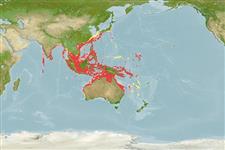Environment: milieu / climate zone / depth range / distribution range
Écologie
marin récifal; profondeur 1 - 100 m, usually 5 - 50 m (Ref. 37816). Tropical; 35°N - 32°S, 72°E - 171°E
Indo-West Pacific: Maldives and India to Papua New Guinea, north to southern Japan, south to Lord Howe Island (Ref. 9710).
Length at first maturity / Taille / Poids / Âge
Maturity: Lm ?, range 16 - ? cm
Max length : 25.0 cm TL mâle / non sexé; (Ref. 2272)
Épines dorsales (Total): 8; Rayons mous dorsaux (Total): 13-16; Épines anales 2; Rayons mous anaux: 12 - 13. Body compressed, its width 3.3-4 in depth (Ref. 37816). Normally yellow, but sometimes nearly all black and juveniles take-on colors of the local venomous Meiacanthus blennies that are yellow or grey (Ref. 48635).
Found mainly in coastal habitats in semi-silty conditions (Ref. 48635); also found near caves and crevices in rocky and coral reefs from a few meters to at least 100 m. A predator that feeds on surprisingly large prey, swallowed whole through its expandable jaws (Ref. 48635). Feeds mainly on fishes. Secretes the skin toxin grammistin under stress (Ref. 2334).
Life cycle and mating behavior
Maturité | Reproduction | Frai | Œufs | Fécondité | Larves
Paxton, J.R., D.F. Hoese, G.R. Allen and J.E. Hanley, 1989. Pisces. Petromyzontidae to Carangidae. Zoological Catalogue of Australia, Vol. 7. Australian Government Publishing Service, Canberra, 665 p. (Ref. 7300)
Statut dans la liste rouge de l'IUCN (Ref. 130435)
Menace pour l'homme
Venomous
Utilisations par l'homme
Aquarium: Commercial
Plus d'informations
RéférencesAquacultureProfil d'aquacultureSouchesGénétiqueElectrophoresesHéritabilitéPathologiesTraitementNutrientsMass conversion
Outils
Articles particuliers
Télécharger en XML
Sources Internet
Estimates based on models
Preferred temperature (Ref.
123201): 24.6 - 29, mean 28 °C (based on 1680 cells).
Phylogenetic diversity index (Ref.
82804): PD
50 = 0.7500 [Uniqueness, from 0.5 = low to 2.0 = high].
Bayesian length-weight: a=0.01820 (0.00693 - 0.04780), b=3.04 (2.81 - 3.27), in cm total length, based on LWR estimates for this (Sub)family-body shape (Ref.
93245).
Niveau trophique (Ref.
69278): 4.0 ±0.65 se; based on food items.
Fishing Vulnerability (Ref.
59153): Low vulnerability (15 of 100).
Nutrients (Ref.
124155): Calcium = 47.4 [26.7, 100.6] mg/100g; Iron = 0.534 [0.290, 1.008] mg/100g; Protein = 18.1 [16.2, 19.9] %; Omega3 = 0.138 [0.082, 0.225] g/100g; Selenium = 33.9 [19.2, 65.9] μg/100g; VitaminA = 80 [21, 353] μg/100g; Zinc = 0.995 [0.649, 1.511] mg/100g (wet weight);
